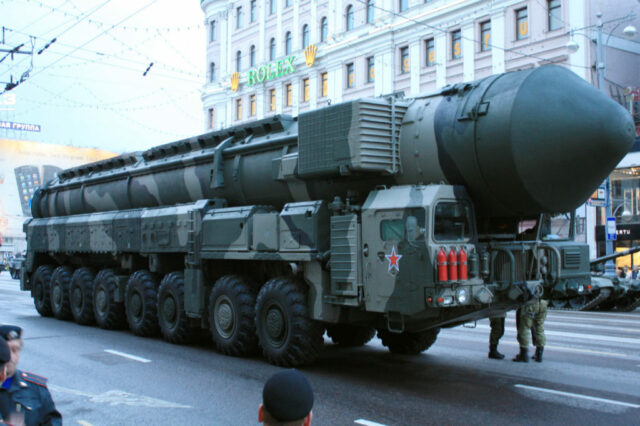
Russia’s Managed Escalation in Ukraine
Publication: Eurasia Daily Monitor Volume: 19 Issue: 168
By:

Russian nuclear escalation threats became the topic of most intense discussion after President Vladimir Putin’s statements on September 21 and 30. In these statements, Putin hinted more explicitly than ever before at the possibility of unconventional escalation if Ukraine continues to liberate its temporarily Russian-occupied territories, which Moscow illegally annexed after sham referendums in late September 2022.
But the possibility of the Kremlin’s unconventional escalation has been a constant factor that has directly impacted US policymaking—even before Russian forces launched an all-out war against Ukraine on February 24. As Russia started to amass troops along its frontiers with Ukraine in the fall of 2021, the Joe Biden administration was devising the United States’ approach from the imperative to simultaneously preserve the world order and not increase the chances for unconventional escalation, which could directly involve the US and the North Atlantic Treaty Organization (NATO) (The Washington Post, August 16, cited by Zaxid.net, August 16).
As Moscow was completing the process of grouping forces for deployment near Ukraine’s borders, the Russian military conducted strategic nuclear exercises on February 19 (Kremlin.ru, February 19). Usually this type of exercise involving the launches of intercontinental ballistic missiles (ICBM), submarine-launched ballistic missiles (SLBM) and mid-range missiles is conducted in November after the conclusion of the armed forces training earlier in the year. The implicit purpose of these snap drills based on Russia’s strategy of escalation management (or in essence dominance) was to deter direct US or NATO intervention on the part of Ukraine in the upcoming invasion (War on the Rocks, June 23, 2020).
Up to the latest of Putin’s explicit escalation threats, a number of cases make it possible to assess to what extent the Russian leadership has been successful with their implicit nuclear signaling. First, the US government refused to take part as an intermediary in the Polish MiG-29 transfer scheme to prop up the Ukrainian Air Force, fearing that such a step might be interpreted by Moscow as direct intervention from Washington with all the hypothetical negative consequences that come with escalation management (European Pravda, March 9). Furthermore, the MiG-29 transfer scheme was deemed undesirable by the US government due to the range of this Soviet fighter, which could technically reach Moscow and therefore may be treated by Russia as a threat worthy of escalation—though the scenario of Ukraine directing the newly acquired MiG-29s to Moscow was quite far-fetched (Al Jazeera, March 9). In the end, instead of being an intermediary in the MiG-29 transfer, the US organized the transfer details for better maintenance of Ukraine’s Soviet-era combat aircrafts (Ukrainian.voanews.com, April 19).
Second, Washington decided that escalation risks attached with a short-range ballistic MGM-140 Army Tactical Missile System (ATACMS) shipment to Ukraine outweigh the military benefits. The Biden administration is fearful that Russia might respond with unconventional escalation if Ukraine employs ATACMS against military targets in temporarily occupied Crimea—though a string of accidents affecting military-related infrastructure in Crimea since August 2022 has yet to result in unconventional escalation by the Russian side (The Wall Street Journal, October 6, cited by RBC, October 7).
Overall, an ATACMS shipment to Ukraine remains a point of disagreement between Washington and Kyiv (Caliber.az, October 9). The Ukrainian government continues to insist that ATACMS remain essential for effective defensive and offensive operations (CNN, October 3, cited by Suspilne.media, October 4). Nevertheless, the Biden administration argues that Guided Multiple Launch Rocket System (GMRLS) ammunition with a range of 85 kilometers or more is enough to meet basic combat needs in long-range fires for the Ukrainian Armed Forces (Focus.ua, August 25). From some public reports, it can be surmised that Washington will be ready to approve ATACMS shipments to Ukraine only after a hypothetical Russian unconventional escalation (e.g., a tactical nuclear strike) (Defense.gov, November 8).
Third, it took one and a half months for the US government to consider the Ukrainian request for M142 HIMARS before approving said shipments. The decision to provide Ukraine with 155-millimeter tube artillery was adopted in a much speedier fashion. In addition, the Biden administration decided to proceed with the M142 HIMARS ammunition shipment only after Ukrainian President Volodymyr Zelenskyy promised not to strike Russia proper with these systems (Bbc.com/ukrainian, June 1).
Yet, despite some of Washington’s risk-averse actions with Kyiv, Russia has not succeeded in preventing US intervention in the form of diverse weapons shipments to Ukraine, which has progressively evolved from light tactical systems (anti-tank guided missiles, grenade launchers, man-portable air-defense systems, etc.) to extended battlefield precision-guided munitions (Harpoon, GMLRS, HARM, Excalibur, etc.).
Another dimension of valuable US aid to Ukraine has been the provision of diverse intelligence information, training, as well as war-gaming. Without this ad hoc multi-prong assistance package from the US, Ukraine would not have been able to sustain critical periods of fighting—in both decreasing Russia’s offensive capacity and laying preconditions for switching to the offensive in eastern and southern Ukraine. Basically, the US government, despite some hesitation and limitations, has managed to find the balance between aiding Ukraine in its self-defense while passing the buck of responsibility for hypothetical unconventional escalation to Russia.



